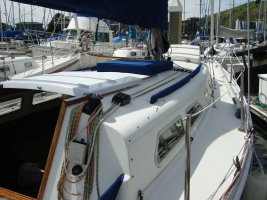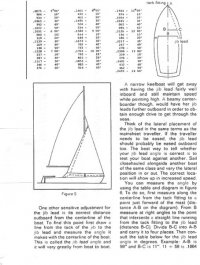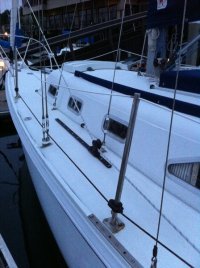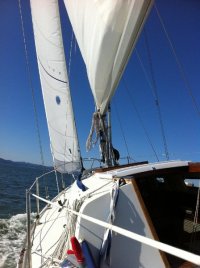The Powers that Be
Pretty good question, Chris.
PHRF will assume any boat racing has efficient sheeting for its' sails.
If you sail a very unusual boat with terrible sheeting angles (of course this begs the question: why would you?), then this point should be made on the rating application and I think would be taken into consideration-remember though, that PHRF is arbitrary-so new boats have very subjective, rather than objective (ala IOR/MORC/IMS/IRC) ratings-but I would think for a new, untried boat, and provided the information is listed on the application you would get some credit.
Pretty moot point, though. Most boats that are in any way suitable for racing have tracks that are, or are VERY close to, the "typical" sheeting angles (11.5-13 degrees for #1 genoas, 9-11 degrees for #3's). Some of the production boats have added short track farther inboard than the "standard" for the #3's & #4's to get better height, but even these boats typically have adequate angles for the #1 genoas.
Keep in mind what was said before: just because you put track farther inboard does not guarantee huge gains going upwind-some older boats are "height" limited by hull and keel shape, and getting the sails closer to centerline will just slow it down.
howyadoinnow?
S
Pretty good question, Chris.
PHRF will assume any boat racing has efficient sheeting for its' sails.
If you sail a very unusual boat with terrible sheeting angles (of course this begs the question: why would you?), then this point should be made on the rating application and I think would be taken into consideration-remember though, that PHRF is arbitrary-so new boats have very subjective, rather than objective (ala IOR/MORC/IMS/IRC) ratings-but I would think for a new, untried boat, and provided the information is listed on the application you would get some credit.
Pretty moot point, though. Most boats that are in any way suitable for racing have tracks that are, or are VERY close to, the "typical" sheeting angles (11.5-13 degrees for #1 genoas, 9-11 degrees for #3's). Some of the production boats have added short track farther inboard than the "standard" for the #3's & #4's to get better height, but even these boats typically have adequate angles for the #1 genoas.
Keep in mind what was said before: just because you put track farther inboard does not guarantee huge gains going upwind-some older boats are "height" limited by hull and keel shape, and getting the sails closer to centerline will just slow it down.
howyadoinnow?
S




